- Author Jason Gerald [email protected].
- Public 2023-12-16 10:50.
- Last modified 2025-06-01 06:05.
An e-bomb is a simple computer trick that can be used to trick your friends (or foes) into believing that their computer has been hacked, has a virus, or has experienced a serious error. The process of creating an E-bomb involves writing a special file using notepad that contains commands to slow down the computer, crash the system, or simply annoy the user, and then trick them into opening the file. There are various kinds of E-bombs, ranging from those that are only a little annoying, to those that can destroy the user's computer system. This article will only teach you how to create a harmless E-bomb, so your victims won't suffer more than a crash. Notes:
The e-bomb described in this article will only work on computers with Windows operating systems and will not work on Macs without special adjustments. Read the first step to get started.
Step
Method 1 of 3: Writing Fake “Virus” to Open Endless New Windows
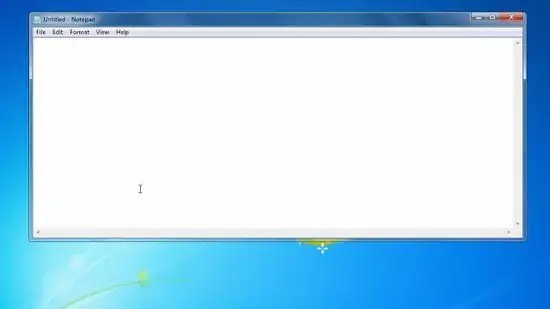
Step 1. Open Notepad
Write the command as a file of type Batch. Files of type Batch (. BAT) contain text commands that will set what the computer should do. To write. BAT files, all you have to do is use Windows' built-in Notepad, no need to bother with other special programs. Generally Notepad can be found in the Accessories folder located in the Start menu.
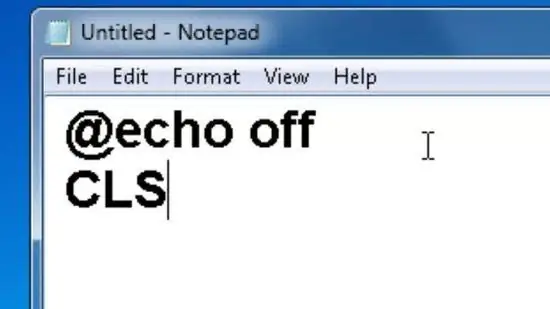
Step 2. Type "@echo off", and "CLS" on the next line
By default,. BAT files will open a Command Prompt window when run. @echo off and CLS will reduce suspicion by hiding the Command Prompt window that should appear when your victim opens a prepared. BAT file.

Step 3. Write a command to open a certain number of new windows (or even infinity
). You have to write a command that will make the fake virus open many new program windows, or even open new program windows with no limit on the number of. The difference is, a computer that keeps opening new windows will eventually crash. Read the instructions below to create both types of “viruses”:
-
To open a new window with a large amount limited, type the following command on the next line: start (name of program you want to force run). Enter the name of the program, or the address of the file you want to run in those brackets. This command will open the program you selected. For example, start iexplore.exe will open an Internet Explorer window. Rewrite the "start" command as many times as you want and the "virus" will open as many windows as you typed. Here are some examples of programs you can use when creating a "virus start":
- iexplore.exe - Internet
- calc.exe - Calculator
- notepad.exe - Notepad
- winword.exe - Word 2013
- To open a new window with the number unlimited, type :A, including the colon, on the next line. On the next line, type start iexplore.exe (iexplore.exe can be replaced with other programs). Finally, type goto A on the line below it. This series of commands will cause the computer to open an Internet Explorer window (or whatever program you choose) and read the commands you typed again, and so on until the victim manages to close Command Prompt or the computer crashes.

Step 4. Insert the message into the “virus” you created
Try to insert a message through the virus that you created to make the victim more sure that his computer is really experiencing an error. To bring up the message, type echo Your message on a new line, and enter the message you want in the “Your Messages” field. Next, create a new line and type pause. This command will make your message appear in the Command Prompt window.
-
To make your “virus” even more believable, use Windows-appropriate messages to warn users when an error occurs. Try to use: Fatal Errors. C:// directory is corrupted.
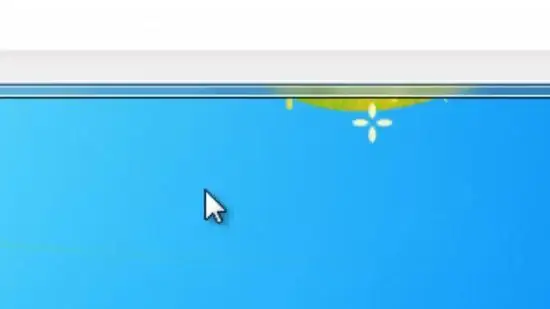
Step 5. Save the file in batch file format
When you're done, choose File > Save As…, and make the file have a ".bat" ending (for example, pinball.bat). Select “All files” in the “Save as type:” option and save the file wherever you want.

Step 6. Finally, you have to “detonate” the created bomb by tricking someone into opening it
There are many ways to complete this step, but one of the most effective is to replace the icon and name "virus" with a program that your victim uses frequently. Make sure you are in a comfortable position to enjoy the victim's wailing!
Method 2 of 3: Creating A. VBS File to Pop Up Error Messages or Hacking
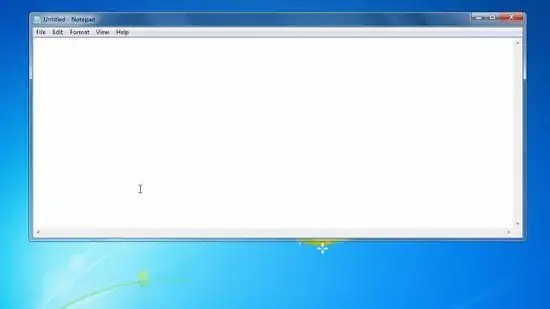
Step 1. Open Notepad
Like the previous trick, you need to type some simple commands using Notepad. Even so, the command you make will not open a new window like the previous one, but instead throw up various error messages that can make victims think that their computer has been infected with a virus or has been hacked.
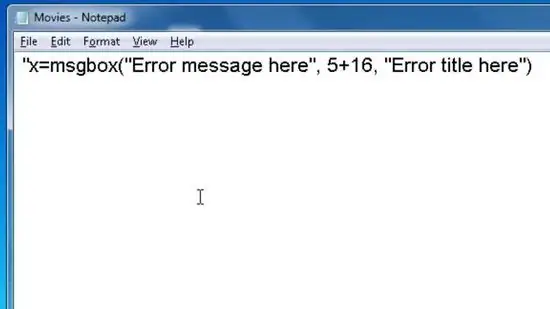
Step 2. Type "x=msgbox("Error message", 5+16, "Error title"). Type this command without removing the brackets or quotes to add the error message and title. This command will cause Windows to issue an error window with the message and title that you defined earlier. To make it more convincing, try to use the error messages and titles commonly used by Windows. For example, “Terminal Error” as the title and “Critical fault detected at C://Users/Windows/system32” as a message.
- You can also create a hacking message like “We are in full control of your computer. Get ready to lose everything.” Even though this message never appears in the actual hacking incident, novice computer users will certainly still feel panicked.
-
The "5+16" command will give two buttons, "Retry" and "Cancel", in the error window that appears. By substituting the two numbers, you can create various error windows. Try using the numbers below to replace 5 with another one-digit number, and 16 with another two-digit number:
- 0 (OK button)
- 1 (OK and Cancel button)
- 2 (Abort, Retry and Ignore buttons)
- 3 (Yes, No, and Cancel buttons)
- 4 (Yes and No buttons)
- 5 (Retry and Cancel buttons)
- 16 ("Critical" icon)
- 32 ("Help" icon)
- 48 ("Warning" icon)
- 64 (Icon “Information”)
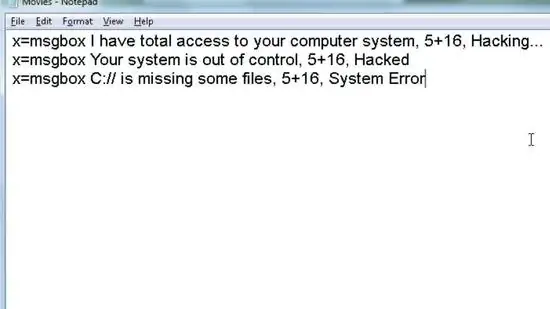
Step 3. Repeat the error prompt as many times as you want
You can also enter any message into the windows that will appear later. The messages you "send" will appear sequentially, or in other words, will appear after the previous message is closed by the computer user. You can take advantage of this sequence by creating messages that seem the longer they are left the more important they become!

Step 4. Save the command sequence that you created as a Visual Basic (VBA) file
When all is done, choose File > Save As…, and add the suffix “.vba” to the end of the file name and make sure you select “All files” in the “Save as type:” option. Finally, you just need to find “prey” to prank. - The trick used in Method 1 can also be used to “detonate” this bomb!
Method 3 of 3: Using Prewritten Batch Files
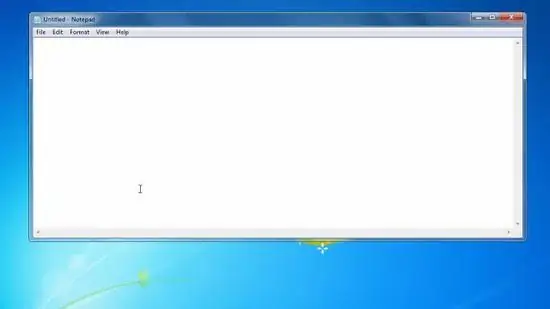
Step 1. Open Notepad
This e-bomb uses Notepad commands to cause the computer to randomly open programs until the batch file is shut down or the computer crashes. To make this one E-bomb, you just need to copy and paste the commands provided in this section. Even so, It should be noted that not all computers can run the following command.

Step 2. Copy and paste the following set of commands into Notepad:
@echo offclsbegingoto %random%:1start cmd.exegoto begin:2start mspaint.exegoto begin:3start pinball.exegoto begin:4start iexplore.exegoto begin:5start explorer.exegoto begin:6start solitaire.exegoto begin:7start explorer.exegoto begin:8start edit.exegoto begin:9start iexplore.exegoto begin:0start mspaint.exegoto begin

Step 3. Change the contents of the command as you wish
This program will open all programs written after the “start” command without stopping. Even though the program starts randomly, the command sequence contains some programs that are written more than once. Try to replace these programs with other programs.
- It should be noted that the computer you are trying to prank may not have some of the programs listed above. For example, not all computers have “pinball.exe”. Double-check the compatibility of the program you wrote with the program on the target computer.
- If you have any doubts about the name of a particular program, keep in mind that the program's location can also be used as a substitute. For example, "iexplore.exe" can also be written as "C:\Program Files\Internet Explorer".

Step 4. Save the file in batch format, and do a test run (if you're brave enough)
When all is done, choose File > Save As…, and add a “.bat” suffix to the end of the file name and make sure you select "All files" in the "Save as type:" option. When you manage to trick someone with this program, their computer will randomly open the program without stopping!
-
To make this trick even more stupid, try to replace the program in one of the "start" commands with a Notepad file or similar document that is on the victim's computer. Use command
edit (file location)
goto begin
to open the file in a DOS-based word processor to make it look as if someone was reading their private document!

Step 5. Learn the meaning of each command to be able to change the E-bomb to your heart's content
By understanding every written command, you'll get even more fun when the bomb explodes, and if not, the E-bomb can still make you at least laugh when it manages to trick someone. In addition, once you understand how E-bombs work, you can start making your own E-bombs! The following is a list of the commands used in this article along with a brief description of their respective functions:
- @echo off - Turns off comments that appear via Command Prompt
- cls - Clears the Command Prompt screen. This command is only useful for making the Command Prompt look tidier.
- goto - Reads the flag you wrote after the command.
- %random% - A Windows variable that will randomly generate a number between (and including) 0-9.
- :(number, letter, or word) - Serves as a Flag. The "Goto" command will make the computer read any flags written after it.
- Note: there are 10 flags listed in the above example. If set, you can make the program stop working after getting a certain number.
Tips
-
Here is a simple but very annoying example of program code:
@echo off
:a
start notepad
goto a
This code will only open Notepad continuously indefinitely until you close the Command Prompt, but if left for a long enough time, for example for half an hour, the computer will experience serious errors.
In general, this code is similar to the alternative method listed above, only simpler.
- Experiment with different codes! If you want to create a malicious program, try entering the command to delete files or the contents of someone's hard disk.
Warning
- Sending malicious batch files intended to modify school or public computers could cause problems for you. Sending a “virus” over the internet to someone who doesn't want it or harassing a public computer is illegal.
- Do not make redundant programs. 10 Pinball windows open at the same time can be very annoying, but hundreds of windows of the same program can crash a computer and possibly ruin someone's work.






